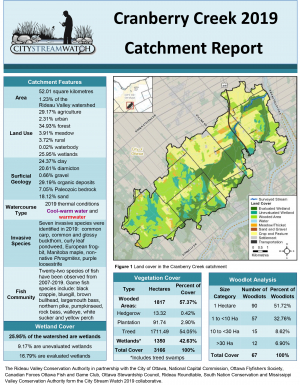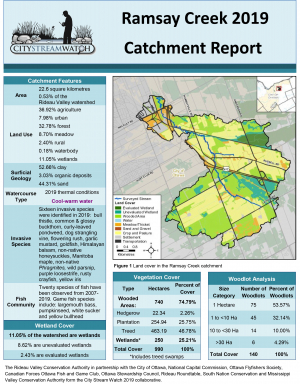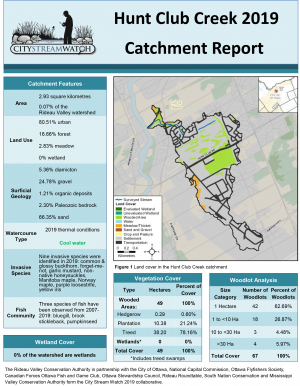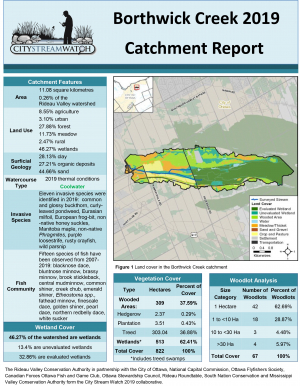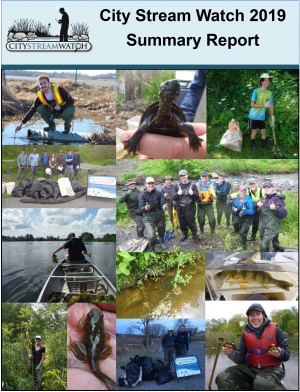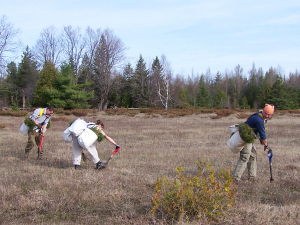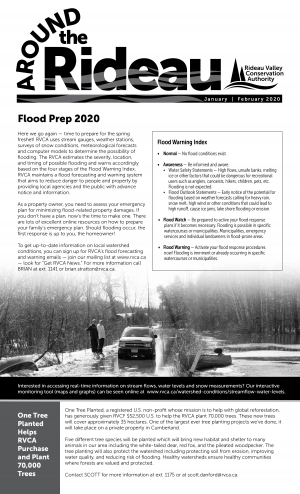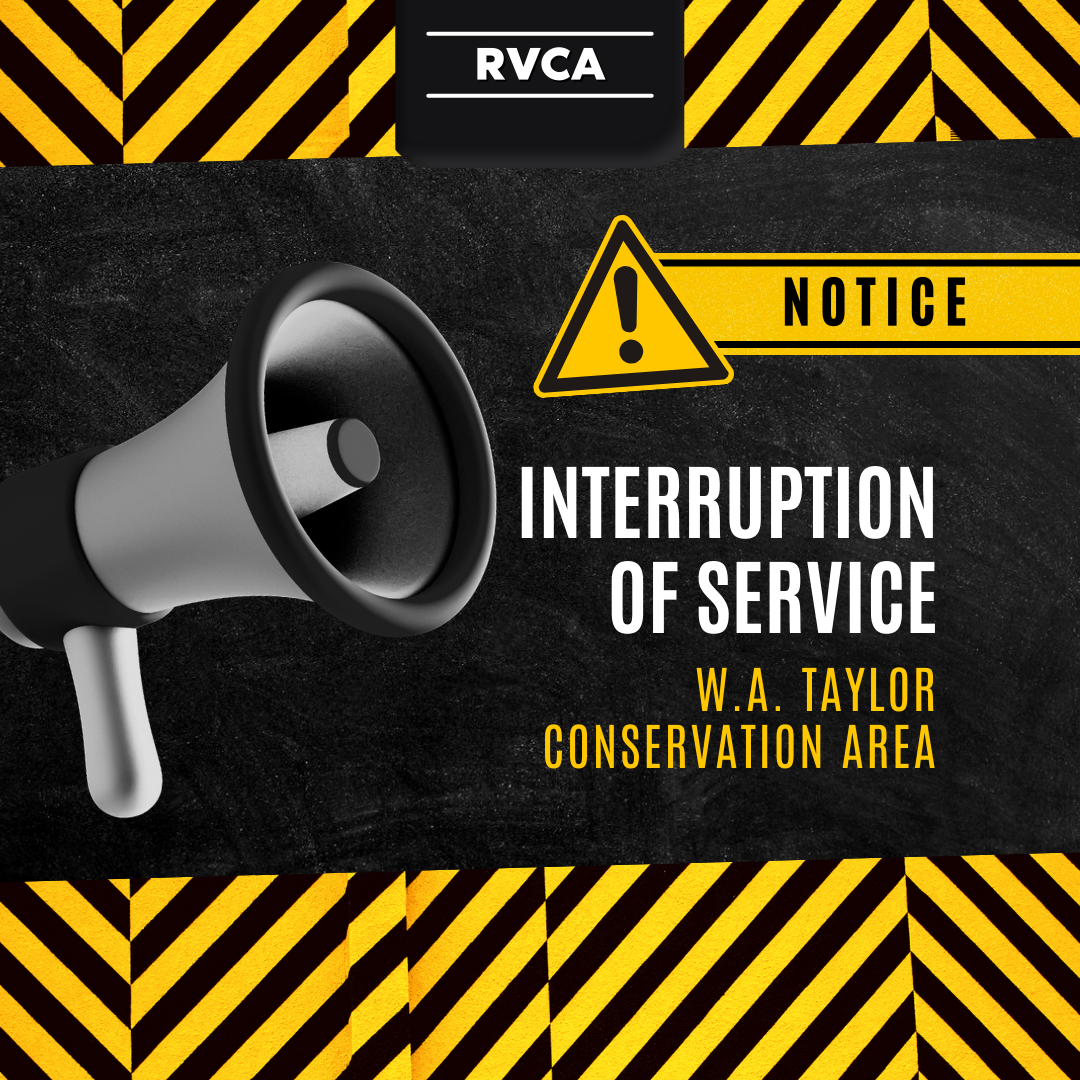Super User
Flood Outlook: Current Spring Conditions Favourable for Slow Snow Melt Across the Rideau Valley Watershed
March 9, 2020 (WCS – R03/2020) — The winter of 2019-20 has been warmer than average with near-average snowfall amounts. On January 11, about 50 mm of rain fell across the Rideau Valley Watershed, resulting in temporarily elevated water levels and flows in all waterways, and a noticeable ice layer within the snowpack. Current conditions at several RVCA and Parks Canada snow course sites are indicating above average water content amounts in the snow for this time of year.
The current short-term forecast indicates daytime high temperatures above zero and below zero conditions at night with precipitation expected tomorrow (up to 15 mm) and Friday (up to 20 mm). This forecast is favourable for ongoing snow melting. If the temperatures and precipitation come as forecast, much of the snow is expected to melt which will make water levels and flows rise over the coming weeks. This gradual process would result in average flooding this spring across the Rideau Valley watershed with inundation limited to low lying areas along all waterways. However, any significant rain events greater than 25 mm and/or significant temperature increases could influence actual flood conditions as we move through March and into April.
Water levels on lakes and flows in the streams are presently about normal for this time of year. Parks Canada staff who manage the water levels for the Rideau Canal have indicated that the levels will be maintained or lowered in the coming weeks to allow for water storage in the upper watershed lakes as the snowpack continues to melt.
City of Ottawa crews have begun the annual ice removal program on the Rideau River between Rideau Falls and Bronson Avenue. Crews will work to keep the ice from reforming until the spring freshet occurs (for more information: City of Ottawa information at 311).
With the changing levels that can be expected over the coming weeks, ice cover on lakes, ditches, local streams, and rivers will continue to be unstable. Extreme caution should be exercised by everyone when near local waterbodies. Parents should inform their children of the risks and provide appropriate supervision.
Residents in flood-prone or low-lying areas, historically susceptible to flooding, should take the necessary precautions to protect their property, such as:
- Ensuring sump pump is clear, in good working condition and has a backwater valve
- Ensuring easy access to a portable backup generator and pump
- Ensuring downspouts are clear and the outlet is at least 3 metres from the dwelling
- Securing items that might float away as flows increase
- Removing valuable items from basements or lower floors that could be subject to flooding
- Keeping emergency phone numbers handy
- Familiarizing yourself with your municipality’s Emergency Preparedness Plan
This watershed conditions statement is in effect until March 31, 2020, at 5 p.m. and will be updated at that time unless the forecast or conditions change.
"Rideau Valley Conservation Authority is a partnership of municipalities within the Rideau Valley watershed created under the Conservation Authorities Act to deliver a range of programs in watershed management and natural resource conservation."
RVCA Watershed Conditions Statements:
- Water Safety – High flows, unstable banks, melting ice or other factors that could be dangerous for recreational users such as anglers, canoeists, hikers, children, pets, etc. Flooding is not expected.
- Flood Outlook – Early notice of the potential for flooding based on weather forecasts, calling for heavy rain, snow melt, high winds or other conditions that could lead to high runoff, cause ice jams and/or lakeshore flooding or erosion.
- Flood Watch – Flooding is possible in specific watercourses or municipalities. Municipalities, emergency services and individuals in flood prone areas should prepare.
- Flood Warning – Flooding is imminent or already occurring in specific watercourses or municipalities.
Cranberry Creek Catchment Report 2019
Ramsay Creek Catchment Report 2019
Hunt Club Creek Catchment Report 2019
Borthwick Creek Catchment Report 2019
City Stream Watch 2019 Summary Report
One Tree Planted Supports the Rideau Valley Conservation Authority in Planting 70,000 Trees
OTTAWA, February 24, 2020 — One Tree Planted, a registered U.S. non-profit whose mission is to help with global reforestation, has generously given the Rideau Valley Conservation Foundation (RVCF) $52,500 U.S. to help the Rideau Valley Conservation Authority plant 70,000 trees. These new trees will cover approximately 35 hectares and will take place on conservation land in east Ottawa.
“We are very grateful to One Tree Planted for this generous gift,” says Diane Downey, RVCF Executive Director. “This investment with help us toward our 2020 goal of planting over 240,000 trees in the Rideau watershed.”
Five species of conifers will be planted which will bring habitat and shelter to many animals in our area including the white-tailed deer, red fox, and pileated woodpecker. The tree planting will also protect watershed health by protecting soil from erosion, improving water quality, and reducing the risk of flooding. Healthy watersheds ensure healthy communities where trees and forest cover are valued and protected.
According to Gabriela Gard at One Tree Planted, “we are dedicated to making it easier for individuals and businesses to give back to the environment, create a healthier climate, protect biodiversity and help reforestation efforts around the world. All by planting trees!”
To learn more about the RVCF and its ongoing work to protect, enhance and conserve the lands and water of the Rideau Valley visit www.rvcf.ca. To learn about local tree planting programs visit www.rvca.ca.
– end —
For more information, contact:
Diane Downey
Executive Director, Rideau Valley Conservation Foundation
613-692-3571 or 1-800-267-3504 ext. 1126
ATR - January-February 2020
Flood Contingency Plan
The responsibility for dealing with flood contingency planning in Ontario is shared by municipalities, Conservation Authorities (CAs) and the Ministry of Natural Resources and Forestry (MNRF), on behalf of the province. The Rideau Valley Conservation Authority (RVCA) 2023 Flood Contingency Plan was prepared in accordance with the provincial standards established in the Ontario Flood Forecasting and Warning: Implementation Guidelines for Conservation Authorities and Ministry of Natural Resources and Forestry’s document.
The purpose of this manual is to provide an overview of how RVCA Flood Forecasting and Warning System operates. Key information presented in this manual includes:
- roles and responsibilities throughout a flood event
- key background information about water management in the RVCA
- RVCA flood forecasting and warning operations
- the RVCA flood message system
This manual is not a municipal emergency preparedness plan and should not be used for that purpose.
The goal of the RVCA Flood Forecasting and Warning System is to provide an estimate of the potential for river and stream flooding in the Rideau Valley watershed and, based on that estimate, give sufficient advance warning to the designated municipal officials and members of the public in order that appropriate steps can be taken to reduce the risk of loss of life, injury, and property damage due to flooding.


